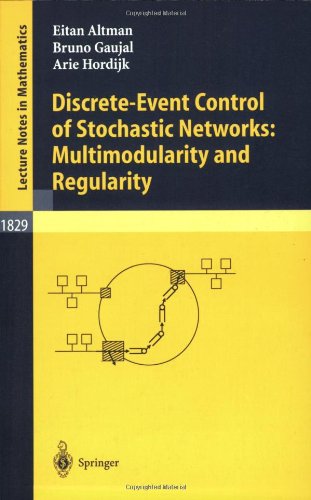
Discrete-Event Control of Stochastic Networks: Multimodularity and Regularity
by Eitan Altman, Bruno Gaujal, Arie Hordijk
Publisher: Springer 2003
ISBN/ASIN: 3540203583
ISBN-13: 9783540203582
Number of pages: 325
Description:
Opening new directions in research in both discrete event dynamic systems as well as in stochastic control, this volume focuses on a wide class of control and of optimization problems over sequences of integer numbers. This is a counterpart of convex optimization in the setting of discrete optimization. The theory developed is applied to the control of stochastic discrete-event dynamic systems.
Download or read it online for free here:
Download link
(2.8MB, PDF)
Similar books
 An Introduction to Nonlinearity in Control Systems
An Introduction to Nonlinearity in Control Systemsby Derek Atherton - BookBoon
The book is concerned with the effects of nonlinearity in feedback control systems and techniques which can be used to design feedback loops containing nonlinear elements. The material is of an introductory nature but hopefully gives an overview.
(11884 views)
 Nonlinear System Theory: The Volterra/Wiener Approach
Nonlinear System Theory: The Volterra/Wiener Approachby Wilson J. Rugh - The Johns Hopkins University Press
Contents: Input/Output Representations in the Time and Transform Domain; Obtaining Input/Output Representations from Differential-Equation Descriptions; Realization Theory; Response Characteristics of Stationary Systems; Discrete-Time Systems; etc.
(14069 views)
 Control in an Information Rich World
Control in an Information Rich Worldby Richard M. Murray - Society for Industrial Mathematics
The prospects for control in the current and future technological environment. The text describes the role the field will play in commercial and scientific applications over the next decade, and recommends actions required for new breakthroughs.
(16261 views)
 Stochastic Modeling and Control
Stochastic Modeling and Controlby Ivan Ganchev Ivanov (ed.) - InTech
The book provides a self-contained treatment on practical aspects of stochastic modeling and calculus including applications in engineering, statistics and computer science. Readers should be familiar with probability theory and stochastic calculus.
(9565 views)